Making good kimchi is so much more than just following a recipe. And that’s my reason for writing the Kimjang post in 2 parts. In Kimjang Day: Part 1, I showed you the overall process of making Kimchi including the recipe. In this post, I will write about how to choose the best ingredients and also helpful tips on making good Kimchi. Everything from salt to chili powder has to be just right for it to taste perfect. Many Korean moms who have been making Kimchi for years will tell you that no two Kimchi tastes the same. I’m sure part of it is because they eye ball everything and don’t really measure (prob. other than the salt water) but the other part is that it depends on so many different factors.
About Kimchi Ingredients
The first thing any experienced Kimchi maker will tell you is that you need to buy good quality ingredients or otherwise no matter how well you make it, it just won’t turn out right. So here are some tips on how to choose the best –
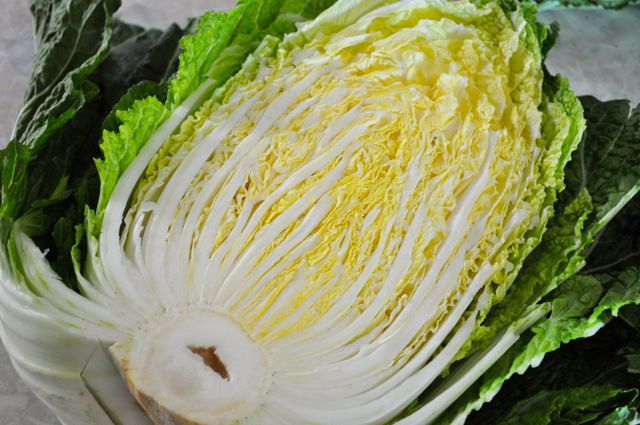
Cabbage (배추 Baechoo) – If you can, buy Korean napa cabbages – they are the best. The better ones are more bigger and heavier with the inner core packed with leaves. A single firmly packed medium size Korean napa cabbage weighs about 3 ~ 4lbs.
Radish (무우 Moo) – Korean radishes are similar to Daikon radishes but are more flavorful and less juicy. Some radishes have little air holes inside which means it’s dried out and will turn spongy. Choose ones that are heavier than others. When cutting radish, my mother-in-law told me that you should pay attention to the grain and cut WITH the grain. This way, the radish remains flexible (and not break) when salted.
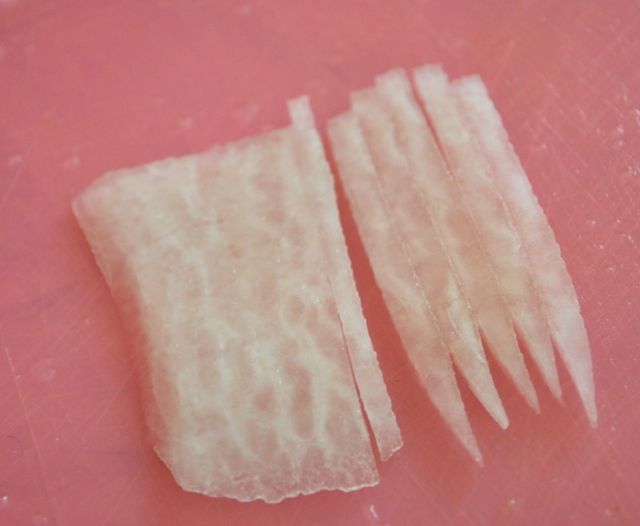
Salt (소금 Sokeum) – Salt is very important in Kimchi. Use sea salt but with the bittern removed. In the old days, people stored a whole sack of solar sea salt (for at least 1 year) on top of bricks while the bittern slowly drained.
Today, companies sell solar sea salt that have been aged for 3 -5 years which means the bittern has been drained for 3-5 years (like the one I mention in K ingredients). If the salt has too much bittern in them your Kimchi may turn out bitter tasting so be careful when you are using sea salt and taste it to see if you can taste any bitterness.
When pickling cabbages, a 1/2 C ~ 1 C salt : 5 C water ratio salt water should work well. And always remember to set aside some of the salt to sprinkle directly in between leaves to ensure even pickling. In warm weather, pickle for 4~6 hrs and in cold weather 8~12 hrs. But always the best way is to touch and see how it looks. See my part1 post to see a pic of pickled cabbages.
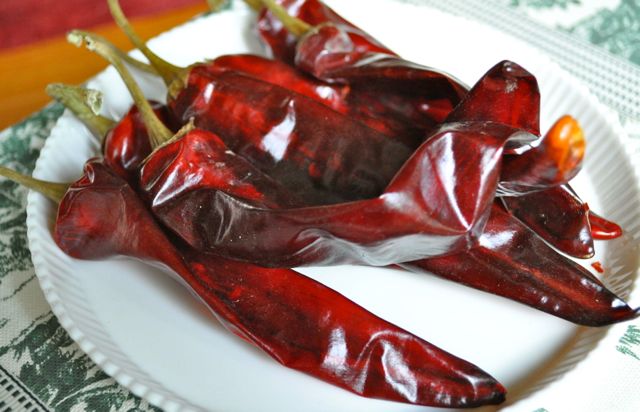
Red chili powder (고추가루 Gochookaroo) – Chili powder can totally make or break a Kimchi. Korean red chili peppers are spicy but not too spicy and also have a bit of sweetness that makes Kimchi taste good. If there’s one thing you should try to buy from the Korean market, it’s the chili powder. Typical amount to use is 1 C of Gochookaroo per 1 cabbage (4 lb size).
Ginger – There is a native Korean ginger that some people like to use but because you use a small amount it does not make a big difference so no need to worry here. Use less ginger if you want to store your kimchi longer.
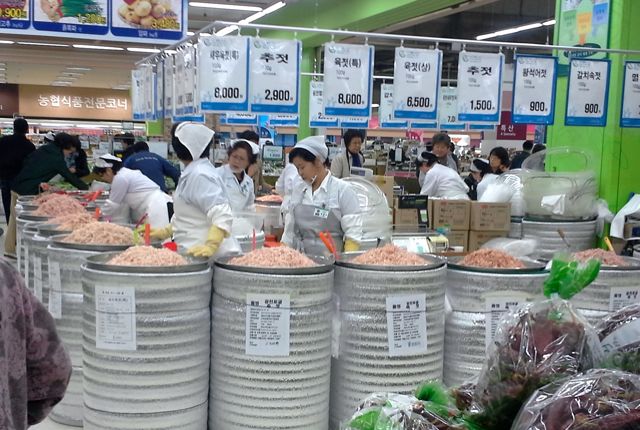
Fermented Fish/Seafood (젓갈 Jeotgal) -Jeotgal is another very important ingredient in Kimchi. What kind of jeotgal you use is very much a personal preference. The better ones should taste pretty good on their own – quite salty, not fishy(the kind of fishy that tastes not fresh) and even a little bit sweet. Anchovy and shrimp jeotgal are your basic must haves. My mother-in-law told me that Kimchi will ripe slower and last longer if you use mostly anchovy jeotgal. Thus, Koreans who live in southern provinces tend to use more anchovy joetgal and Koreans who live in the central and northern part tend to use more shrimp jeotgal. What jeotgal you use also depends on what kind of kimchi you are making – more shrimp for Kkaktooki and more anchovy for Kimchi that are made with greens such as chives and mustard leaves.
The picture shows all the different kinds of saewoojeot that you can buy based on where it is from and also when they are made. Saewoojeot made in May is called 오젓 Ohjeot, in June is called 육젓 Yookjeot and in the fall it’s called 추젓 Choojeot. June jeotgal (Yookjeot) is the best for Kimjang.
I know it’s hard to get all these fancy fermented jeotgal outside of Korea so just use one or more of the bottled fermented anchovy sauce (멸치액젓 myulchi aekjeot), fermented sand lance sauce (까나리액젓 kkanari aekjeot) or fermented shrimps (새우젓 saewoojeot). If you can’t even get these, use any Asian fish sauce.
Rice Paste VS Flour paste for Kimchi?
This is another ingredient that varies a lot based on the recipe and puzzles even Koreans as to whether this is a necessary ingredient. There are different opinions and I personally prefer not using the paste so it was not included in my Kimjang recipe. But you are welcome to add it if you wish.
There are 2 main reasons for adding paste in Kimchi.
- It gets rid of any “grassy” smell and taste from some Kimchis. When making Kimchi with dark green vegetables (radish leaves, Korean small cabbage, mustard leaves, etc but NOT napa cabbage), it can sometimes taste and smell grassy. The only way I can explain “grassy” is that it would be mildly similar to eating wheat grass or something that is so green that it tastes really raw and even bitter. Rice or flour paste is a must for these green kimchis and also for radish kimchis like Kkaktoogi.
- It helps to ripen Kimchi faster and taste sweeter. Because it serves as food for the many beneficial lactic acid bacteria that helps ripen Kimchi, it speeds up the fermentation process. So if you don’t want to ripen your Kimchi too fast, don’t add any paste. Personally I think it diminishes the fresh taste of Kimchi and takes away some of the zing that I love in a great Kimchi. But some people (many from the Southern region) actually prefer it this way and they say it deepens the taste and has a more concentrated flavor.
FAQ
- Q: What if I don’t have access to Jeotgal?
- A: You would think that it would be impossible to make Kimchi without some kind of fermented seafood. But it’s actually not true. An easy possible substitute is Fish Sauce (which is usually readily available than Korean jeotgal). But you can completely omit jeotgal and just add some fresh shrimp, fish stock (dried anchovy or pollock) or beef stock(with fat removed) instead.
- Q: My Kimchi is not salty enough. Can I add additional salt after Kimchi has started to ferment?
- A: It is best not too. Adding additional salt afterwards can actually make it taste bitter. But before it has started to ferment, you can take out some of the juice, add salt and mix, then add it back in.
- Q: How can I make my Kimchi not sour too quickly?
- A: The saltier you make your Kimchi, the longer it will take to ripen and also will not sour as quickly. Not adding paste or jeotgal will slow down the ripening process. Koreans sometimes make Kimjang Kimchi with just salt so they can make it last till summer. Adding sugar will make Kimchi taste sweeter but also sour faster. Let it ripe but then keep it in very cool temperature – see No Crazy Kimchi post for more info on how to ripen Kimchi.
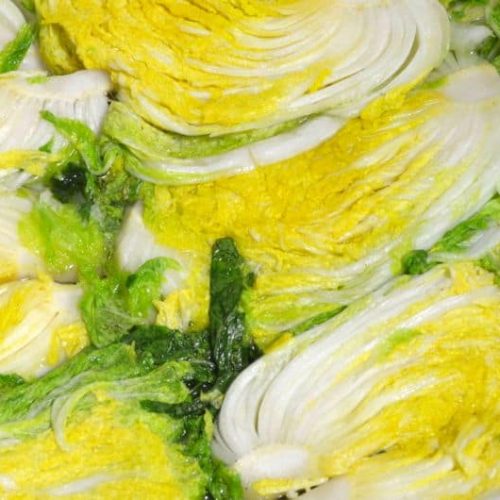
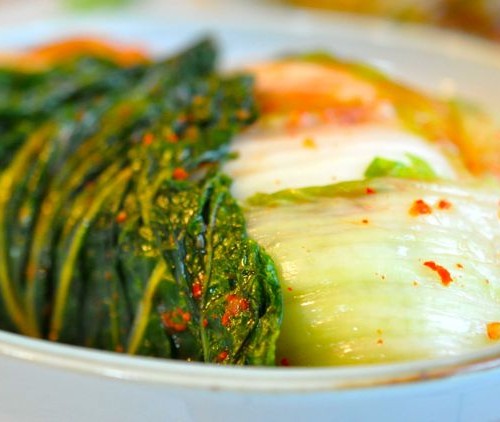
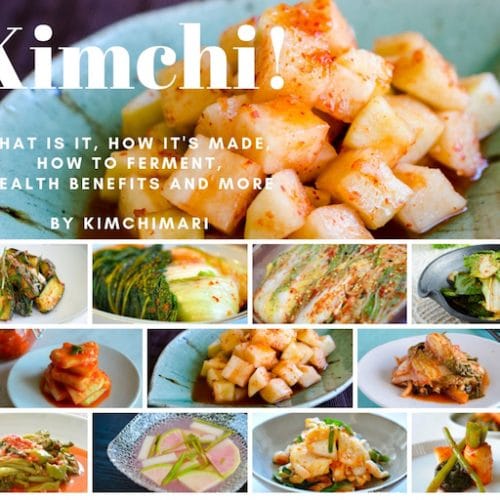

















I want to get fish sauce to use in making Kimchi but I am allergic to shell fish. Do you have any recommendations on a brand of fish sauce I can use that would be safe for me?
Hi, so Korean fish sauces are usually made without shellfish. So if you buy Korean anchovy sauce or Korean Sand Lance fish sauce they should all be safe. You can buy them on amazon and of course, be sure to check the label. Good luck!
I just found your page. I wished I would have found it before trying my first batch of kimchi. I love kimchi with everything but I am a novice at knowing what is good or bad. I do not have access to Korean red chili’s. However; I have go Huns get paste. My question is, can this be used for making kimchi? Or should I just go ahead and use what I have made in cooked dishes?
Hi David, happy to hear that you found my page helpful. If you are asking whether you can make Kimchi with Gochujang – no sorry Koreans don’t do that. You will need dried red chili powder. Good luck!
Hi! I made kimchi using blended white rice porridge since i have no rice flour or flour available. will it still be fine?
Yes, it should be fine. As long as the amount is similar..
Should have stated gochujang paste